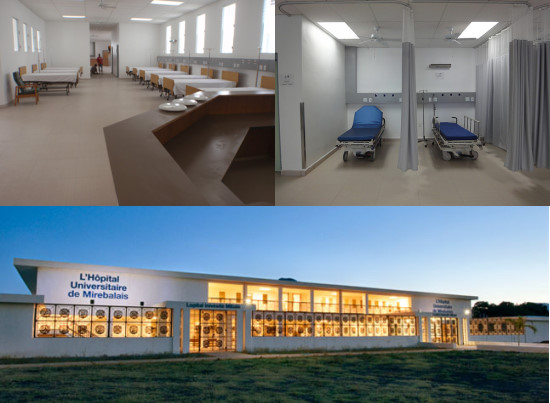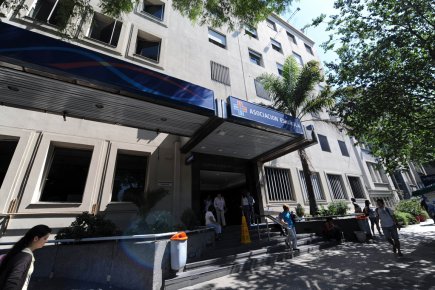Widgetized Section
Go to Admin » Appearance » Widgets » and move Gabfire Widget: Social into that MastheadOverlay zone
MIREBALAIS: HOSPITAL CONSTRUCTION COMPLETE
Partager/Share this

The construction of Hôpital Universitaire de Mirebalais, just north of Port-au-Prince, Haiti, is complete, thanks to the support of hundreds of people in Haiti, the United States, and around the world. Drs. Maxi Raymonville and David Walton, physicians for PIH/Zanmi Lasante and members of the executive leadership team of Mirebalais National Teaching Hospital, give us an update on its progress—and what’s to come.
Q: Why did PIH/Zanmi Lasante decide to build Mirebalais Hospital?
After the January 12, 2010, earthquake devastated Haiti’s largest public teaching hospital, nursing school, and other critical medical infrastructure in Port-au-Prince, Haiti’s Ministry of Health asked us to dramatically scale up our existing plans for a small community hospital we were planning to build in Mirebalais, just 60 kilometers north of the capitol. The result is the Hôpital Universitaire de Mirebalais—HUM for short—a 205,000-square foot, 300-bed facility. The hospital will fill a huge void, locally and nationally, for people who previously had limited access to quality health care, as well as improve access to training for Haitian physicians, nurses, and allied health professionals.
Q: Now that construction is nearly complete, what is your team focused on?
At this point we are currently focused almost exclusively on operational planning—we’re setting up structures for governance and staffing, developing plans for hiring, and creating standard operating procedures for how everything will run when the hospital opens. We’re also working on curricula, developed with our main educational partners at the Université d’État d’Haiti to train Haitian nurses, doctors, community health workers, and other health professionals, which will strengthen the next generation of health providers.
We’re also looking forward to Nov. 6, when Dr. Jim Yong Kim, a PIH co-founder, makes his first official visit to Haiti in his role as president of the World Bank. In honor of his visit, ZL and the Ministry of Health will host a ribbon-cutting ceremony that will mark the completion of our hospital construction efforts. This event celebrates PIH/ZL’s partnership with Haiti’s public sector, and we’re especially excited that President of the Republic Michel Martelly will attend.
We’re continuing to work with the Ministry of Health to open the hospital as soon as possible and will have a dedication ceremony in early 2013 to celebrate the culmination of this work and the partnerships that have made it possible.
Q: How many people do you expect will use the hospital?
The hospital will provide primary care services to approximately 185,000 people in Mirebalais and two nearby communities. But patients from a much wider area—all of central Haiti and areas in and around Port-au-Prince—also will be able to receive secondary and tertiary care at this facility. We could see as many as 500 patients every day in our ambulatory clinics when we are fully operational.
Q: What are some of those primary care services?
They include everything from community health services to HIV/AIDS and TB care, care for non-communicable diseases, and prenatal care. Patients will receive vaccinations and treatment for malnutrition, for example, as well as basic primary care and dental services. We will also offer secondary level services including mental health, emergency medicine, and general and orthopedic surgery. Our women’s health services include family planning, reproductive health, and comprehensive emergency obstetric care. We aim to provide the same services you would find at any U.S.-based hospital.
Once the hospital is running at full capacity, we’ll have more than 30 outpatient consulting rooms, six operating rooms, and space to host trainings for 200-plus participants.
Q: How many people will the hospital employ?
We’ll eventually employ more than 1,000 people—including 175 community health workers—drawn primarily from the Mirebalais area.
Q: How much did it cost to build the hospital? And how much will it cost to run each year?
Thanks to incredibly generous supporters, we have raised $17 million to design, build, and outfit the hospital and residences, and we have received another $5-6 million in in-kind donations. When it opens, the hospital’s operational budget is estimated to be about $12.5 million for each of the first two fiscal years. PIH/ZL and the Ministry of Health are still finalizing the budget and both entities will share the cost of running HUM, providing high-quality health care to poor people through Haiti’s public sector.
We will continue to rely on our friends and supporters who believe we can—and should—provide health care to people everywhere, and especially to people living on the margin of extreme poverty. We are also working out a mechanism for long-term financing with the Ministry of Health and other sources.
Q: How will the hospital be governed?
ZL and PIH will operate the hospital under a Memorandum of Understanding with the Ministry of Health for several years. We hope, with the Ministry’s consent, to form an HUM Advisory Board shortly after opening the hospital. The board would ideally be comprised of executives from the Ministry of Health, Zanmi Lasante, PIH, and private citizens who would be advocates and supporters of the hospital. We would hope that within two years, the Advisory Board could become a governing board. Composition of the board(s), timing of their formation, authority, and other related issues will be agreed with the Ministry of Health after the hospital opens.
Eventually the Ministry of Health will manage the hospital, but in the meantime we’ll use an accompaniment and mentorship approach to pair Haitian leaders with international experts from the United States and elsewhere who will help launch the hospital and then steward this transition. This will enable HUM to demonstrate best practices in hospital management, and establish a strong Haitian leadership team that can make the hospital a success and a model for public hospitals throughout the country.
Q: Explain more about the hospital’s role in improving nursing and medical education in Haiti.
Haiti’s public health sector lacks resources to provide attractive career options for young health professionals—many decide to work in private facilities and a vast majority leave the country altogether. We want to help retain health professionals for the public sector here by creating an environment that offers the tools, resources, supervision, and mentoring and academic environment they need to be satisfied in their jobs and advance in their careers.
To that end, PIH/ZL is working with l’Université d’Etat d’HaÏti, l’Ecole Nationale des Infirmières [the national medical and nursing schools, respectively], and other international partners to develop academic programs to train future generations of nurses, doctors, and other health professionals. We will offer medical residencies at HUM in several areas, including internal medicine, obstetrics and gynecology, and surgery.
The hospital also will serve as a site for clinical rotations for Haiti’s national nursing schools, and offer nurses advanced training in several specialty areas, including emergency care, neonatal intensive care, and surgery.
Q: How will HUM impact the economic life of Mirebalais?
Based on PIH’s experience opening a full-service hospital in the rural settlement of Cange, the town of Mirebalais can expect to see remarkable growth and opportunity with the opening of the hospital. We anticipate seeing larger economic growth in the form of new hotels, restaurants, and other small businesses to cater to the increased flow of goods and people in and out of Mirebalais.
Ultimately, we expect HUM will affect the community’s economy on three levels. First, direct employment of more than 1,000 staff in Mirebalais; second, the benefit of those salaries on their families (the ability to keep their kids in school, for example); and third, business growth that will stem from fulfilling the needs of these new professionals.
Q: Talk about some of the building’s “green” aspects—how did the hospital incorporate sustainable building practices and green technology?
Our green technology plan incorporates electricity conservation measures, natural ventilation and lighting, water-efficient plumbing, and a solar energy system that’s among the most ambitious health sector solar projects ever undertaken in a developing country. In fact, according to publicly available data, HUM will be the largest hospital in the world that can be powered entirely by solar energy.
Working with the Ministry of Health, we chose to use solar power as a cost-effective, reliable, and environmentally responsible way to help power the facility and avoid the burden of Haiti’s frequent blackouts. On most sunny days, the system’s 1,800 solar panels will generate more electricity than the hospital consumes, allowing the surplus energy to feed back into the electrical utility.
In addition to solar power, the hospital minimizes energy needs through high-efficiency fluorescent light fixtures, motion sensors for lights that will save up to 60 percent in energy usage, and natural ventilation that reduces both the spread of infection and the need for air conditioning. On the roof, reflective white coating keeps the building cooler and makes the solar panels up to 15 percent more efficient.
All this new technology is being introduced with an eye toward sustainability—all the equipment will be regularly serviced by professionally trained Haitian staff.
Q: What does this hospital symbolize for you?
HUM offers an incredible opportunity to raise the standard of health care for our patients in Haiti. In partnership with the government, we have the capacity to provide high-quality services drawing on international best practices for healthcare delivery, administration, and education. We hope that our work will improve care both throughout our PIH/ZL network and across Haiti.(From the PIH/ZL website)
Partager/Share this

























































